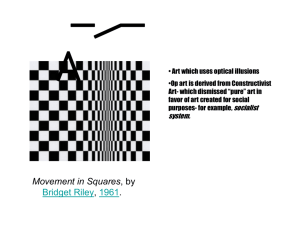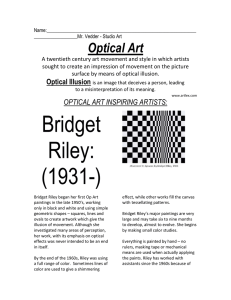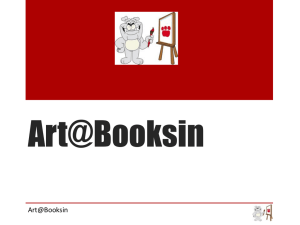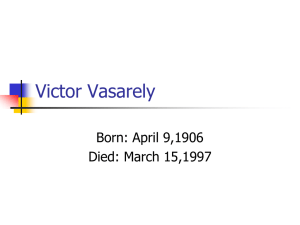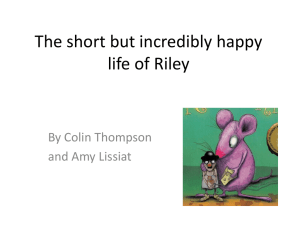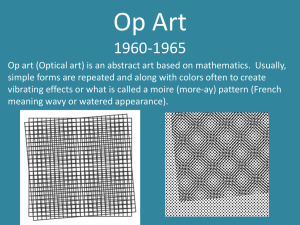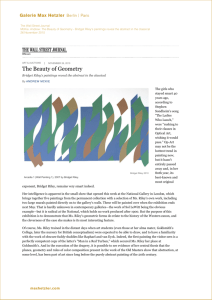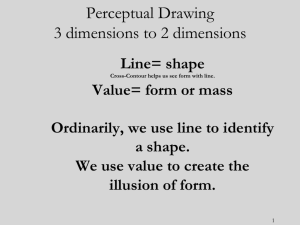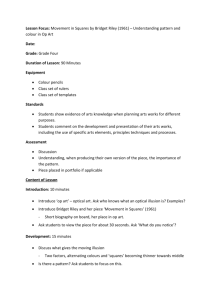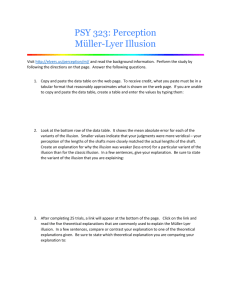Op Art: Working With Optical Illusions Review Questions
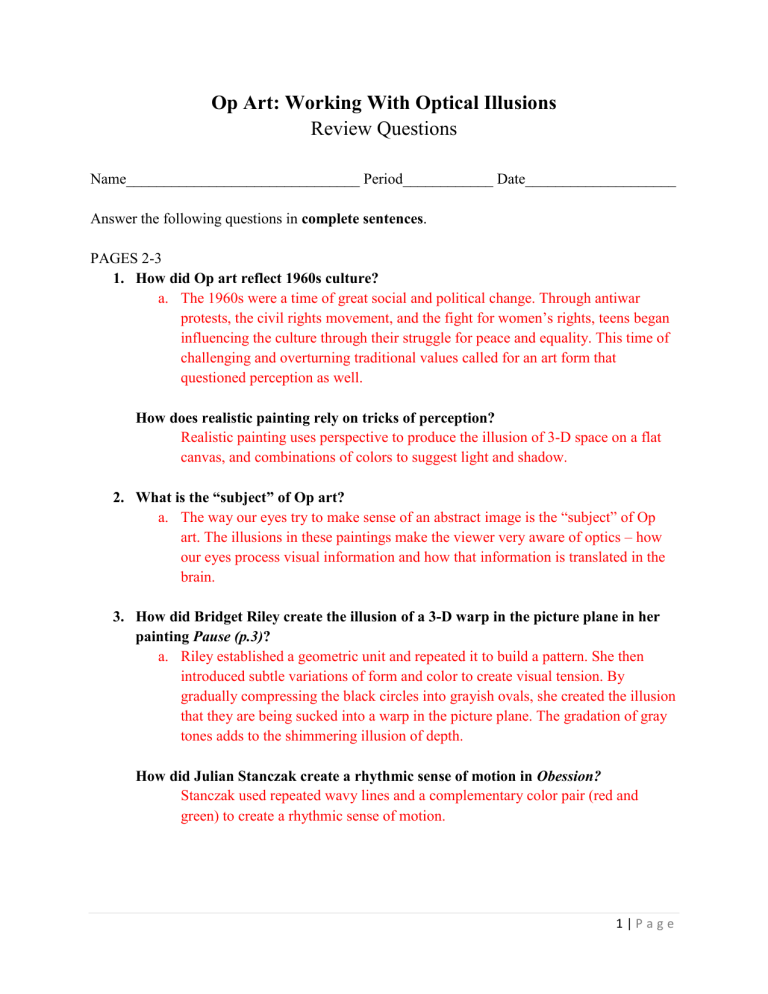
Op Art: Working With Optical Illusions
Review Questions
Name_______________________________ Period____________ Date____________________
Answer the following questions in complete sentences .
PAGES 2-3
1.
How did Op art reflect 1960s culture? a.
The 1960s were a time of great social and political change. Through antiwar protests, the civil rights movement, and the fight for women’s rights, teens began influencing the culture through their struggle for peace and equality. This time of challenging and overturning traditional values called for an art form that questioned perception as well.
How does realistic painting rely on tricks of perception?
Realistic painting uses perspective to produce the illusion of 3-D space on a flat canvas, and combinations of colors to suggest light and shadow.
2.
What is the “subject” of Op art? a.
The way our eyes try to make sense of an abstract image is the “subject” of Op art. The illusions in these paintings make the viewer very aware of optics – how our eyes process visual information and how that information is translated in the brain.
3.
How did Bridget Riley create the illusion of a 3-D warp in the picture plane in her painting Pause (p.3) ? a.
Riley established a geometric unit and repeated it to build a pattern. She then introduced subtle variations of form and color to create visual tension. By gradually compressing the black circles into grayish ovals, she created the illusion that they are being sucked into a warp in the picture plane. The gradation of gray tones adds to the shimmering illusion of depth.
How did Julian Stanczak create a rhythmic sense of motion in Obession?
Stanczak used repeated wavy lines and a complementary color pair (red and green) to create a rhythmic sense of motion.
1 | P a g e
Carlos Cruz-Diez used only three colors (blue, purple, and orange) plus black in his untitled silkscreen. Why do our eyes perceive two different shades of blue?
Our eyes imagine two different shades of blue because blue looks different when it is placed next to orange than it does when it is placed next to purple.
Contrasting one color with another affects how we perceive both colors, due to an optical process called simultaneous contrast.
What was
“The Responsive Eye”?
“The Responsive Eye”
was an important exhibition held at the Museum of
Modern Art in New York in 1965. It brought Op art to the world’s attention. The show featured over 100 artists from 15 countries, including Bridget Riley, Victor
Vasarely, Julian Stanczak, and Carlos Cruz-Dies.
How did critics respond to the exhibition?
Critics called the show “an optometrist’s nightmare” and a “roller-coaster ride.”
One even suggested viewers take motion-sickness pills before seeing the show.
4.
How did the public respond to “The Responsive Eye? a.
The public flocked to see the show. They were fascinated by Op art’s capacity to alter reality and to generate physical sensations in the viewer. “The Responsive
Eye” became the most popular show in MoMA’s history up to that point.
How did Op art influence other areas of culture?
The craze for Op art extended into fashion and interior design. Op art-inspired patterns appeared on everything from dresses and scarves to furniture and wallpaper. Some artists welcomed the commercialization of their ideas, while others protested it. In 1965, Bridget Riley tyried unsuccessfully to sue a clothing company that had used one of her paintings as a fabric design.
PAGE 4-5
What historical painting style inspired Bridget Riley to experiment with optical effects?
The painting style known as Pointillism inspired Riley to experiment with optical effects. In the late 1950s, Riley developed an interest in the Pointillist work of the
19 th
Century French painters Georges Seurat. Seurat used tiny dabs of pure color to portray landscapes and scenes of city life. Seen from a distance, these dots of color appear to blend together in the viewer’s eye to suggest recognizable forms.
5.
How did Riley create the illusion of depth and movement in Blaze 1 ?
2 | P a g e
a.
Riley used diagonal black and white lines to design a spiral structure. By reducing the thickness of the lines toward the center of the image, she created a dizzying illusion of depth and movement. The spiral seems to vibrate with a hypnotic energy.
6.
Why did Riley title her painting of black circles on a white background White
Discs1 ? a.
If you focus on the image with a steady gaze, after a while your eyes will invent the white discs referred to in the title as afterimages floating abouve the white background.
7.
What is an afterimage? a.
An afterimage is an optical illusion that happens when the part of your eye that perceives color becomes so tired that it “sees” the opposite of the original color.
8.
How did Op artists apply paint to the canvas? Did they use expressive brushstrokes? a.
Op artist applied paint to the canvas in flat, clean, hard-edged lines, paying close attention to detail. They did not try to communicate their personalities or emotions through expressive brushstrokes. In fact, many Op artists – including
Bridget Riley and Victor Vasarely – hired assistants to complete their paintings for them.
PAGES 6-7, 8-9
9.
How did Victor Vasarely create the illusion of a bulging convex form in Vega 200
(cover)? a.
Vasarely repeated and varied a simple pattern of circles on a grid to produce this optical effect. Vasarely knew that warm colors like red tend to advance in space, while cool colors seem to recede into the distance. Enlarging the red circles at the center of the image creates the impression that they are closer to us. The part of the image that seems farther away contains smaller circles painted in cool tones.
Why can Stri Pauk be considered an unstable image?
Stri Pauk can be considered an unstable image because the viewer can make sense of the geometric forms in several contradictory ways. The perspective shifts depending on which plane your eyes focus on.
10.
Why is Ambigu-B (pp 8-9 an impossible object? a.
Ambigu-B is an “impossible object” because this 3-D form could never exist in real space. The rectangular plane in the exact center of the painting can belong to either of two completely different 3-D forms, but not to both.
3 | P a g e
How did Vasarely create the illusion in Ambigu-B?
Vasarely devised this illusion by designing separate but overlapping forms and having them share a common side. The compositional elements work against each other to create a feeling of instability.
What effect do the gradations of color create in Gestalt-Rugo ?
The gradations of color in Gestalt-Rugo create paths for the eye to follow and make this 3-D form appear to shimmer in the light.
11.
What kind of art did Vasarely want to create? a.
Vasarely wanted to create a democratic form of art that would be accessible to everyone, not just viewers with a certain educational background. He developed a system of working so that his designs could be inexpensively reproduced in virtually unlimited numbers as posters, fabrics, tapestries, and other products.
How did Op art reflect Vasarely’s motto of “art for all”?
Op art is democratic because there is no story to tell, history to know, or hidden meaning to understand in these paintings. They generate visual sensations in every pair of eyes that takes the time to look at them.
PAGES 10-11
What is a visual pun?
When a single image can be understood to have two different but related meanings, it’s called a visual pun.
12.
How did M.C. Escher create the visual puzzle in Relativity (p. 11)? a.
Escher created this visual puzzle by playing with the rules of perspective (the system that makes it possible to represent depth of a flat surface.) One important rule of perspective states that all parallel lines receding into the distance must pass through a single point in the picture plane, called the vanishing point. Instead of one vanishing point, Relativity has three.
How did Sally Bennett Jones use color to organize her quilt?
The yellow (blue’s complement) tones of the quilt’s busily patterned border contrast with the blue in the central panel. Small patches of blue in the border add visual accents and tie the design together into a harmonious whole.
4 | P a g e
PAGES 12-13
What are the focal points of Jeremy’s composition? What draws the viewer’s attention to these focal points?
The focal points of Jeremy’s composition are the eye and the mouth. In these areas, the ribbons are very tightly woven and detailed. These are also the only two parts of the drawing where Jeremy used color.
PAGE 16
Answers:
1.
All
2.
All
3.
A, B, C
4.
C
5.
All
6.
All
7.
A,D
8.
All
9.
All
10.
All
11.
B (A)
12.
A
13.
D
14.
All
15.
B
16.
B, C
17.
B, D
18.
B
19.
All
20.
B, C, D
21.
B, (A)
5 | P a g e
